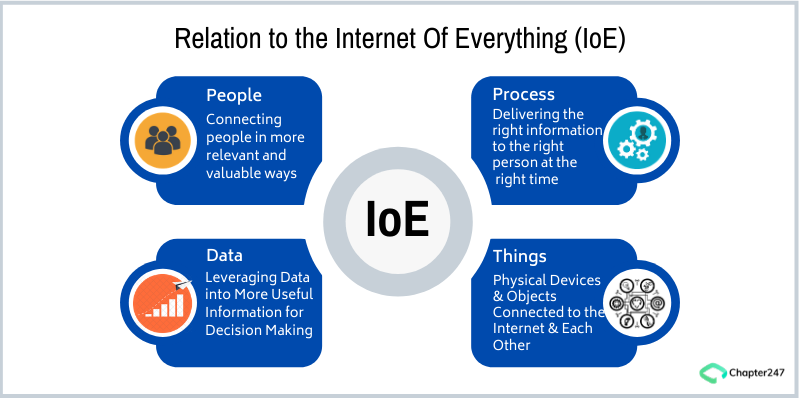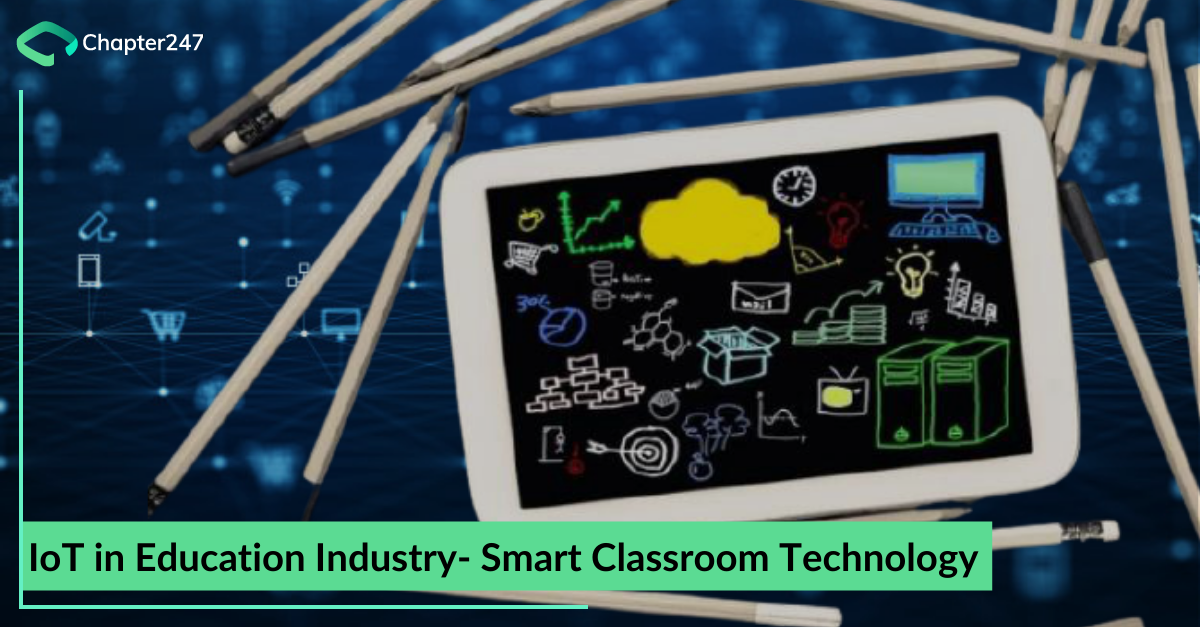IoT in the education sector has proven to be a game-changer as more and more education institutions are using smart devices to provide e-learning options.
Your phone beeps, and you get a message saying, Your ward XXXX has registered his attendance for his 1’st class at 8.30 am” Parents will apparently have a sigh of relief considering their kid is attending their college every day. But, the message that the parent received is directly connected to the biometric device installed at schools and colleges tracking the regularity of the students, giving them no scope to cheat!
Yes, That’s IoT in progress.
Like in many sectors, IoT has been a benefaction in the education industry. From an online course to the concept of “flipped classrooms”, IoT in the education industry has expanded learning opportunities and provided tools and stuff to educators that have eased the process of learning.
According to a survey, California had passed a law in 2009 requiring that all the college textbooks should be in the e-form by 2020. Two years later, Lawmakers in Florida passed another law that demanded public schools to not function with a paper-based textbook and instead convert into digitized versions of it. Many countries are now resorting to smart classroom technology and amongst the major emerging technologies, IoT is considered the most trending.
IoT or the internet of things is the expansion of internet connectedness into various physical devices and objects used everyday. The whole system of IoT is lined with effectual versions of electronics, hardware and internet connection. The education sector has gone a notch higher and has taken every step in ensuring the technology is embraced by them.
What is IoT?
A reasonably simple way of explaining IoT is this: You are reading this post and we are sure either on your desktop or on a mobile device and even on tablets. Whichever device you are reading this content on, it is but obvious that it is connected to the internet.
Now we all know that the Internet is one of the best things to have happened to humans. Imagine your older phones which were not smart enough! All you could do with them was to send and receive calls and messages. But now you can listen to songs, watch movies, chat live and a host of other things. Connecting to different things you do with the internet is one of the most amazing things which is what IoT is about! I know this is still confusing, but as you read the article you will understand how IoT has influenced the education industry majorly.

The Huffington Post Stated that “The Internet of Things (IoT) will soon be called the Internet of Everything (IoE). By the year 2020, more than 50 billion connected devices are going to be present on the Internet”
Let’s also give you a formal definition of IoT to get you going.
According to Wikipedia, “The Internet of Things (IoT) is a system of interrelated computing devices, mechanical and digital machines, objects, animals or people that are provided with unique identifiers (UIDs) and the ability to transfer data over a network without requiring human-to-human or human-to-computer interaction.”
Why is IoT important in the Education Industry?
Schools and colleges have been late in adopting smart classroom technology despite noticeable progress in technology trends in the educational industry. But, now the trend has been picking up and stakeholders are doing everything to leverage technology and change the way teaching is done.
But we are still late because we are yet to realize how important it is now. It is true that any change can be difficult initially, but once it has been embedded it becomes a regular feature. Modernizing the education sector with smart classroom technologies can be a key step to bolster productivity and to improve the quality of education.
In one of the surveys conducted by Microsoft and YouGov, about 60% of the parents were optimistic and excited about smart classroom technology and believe it will play a big role in a child’s life. Also, 86% also said technology in schools will definitely have a positive impact on their kid’s education.
One size fits all is not true anymore, because the emerging technologies have done much to change age-old ideologies and thought processes. Classrooms have changed. Teachers admonishing the students for passing notes have become a thing of yesterday. Electronic devices are now customary in schools and teaching methods are also focusing on becoming more interactive and also usable in real-world scenarios.
Let us explore the key applications of IoT in Education?
Attendance tracking
When this was not around, many students had their attendance well above the required limit thanks to the proxy voting system. Many schools have different rules concerning attendance. Some need at least 60%, while others 80% for the students to appear for the examination. Thanks to IoT, management can now extract appropriate attendance data leading to saving time. Employee satisfaction bounds to rise once they discover that their disposable time has increased.

Also with accurate tracking taking place, it will encourage students to become regular to classes. Let us see some other benefits of IoT:
- There is no superfluity in data because of low human intervention. About 99% of the data is accurate because data redundancy is next to zilch.
- For Real-time smart tracking of the location of students, this is a wonderful tool.
- With the help of IoT based biometric devices authentication and security, enhancements are a guarantee.
- Generating attendance based reports can be frustrating, but with IoT, report generation is way easier.
Smart Boards
Black & Whiteboards are a thing of the past. A current lot of students enjoy learning on smart boards because it is a highly interactive device to work with. But, how? What if we tell you that animal dissection can now be done on virtual animals! Or in order to see what real-life lava looks like, you can see a virtual volcano erupting! These mesmeric learning technologies make learning an engaging experience which increases student motivation. Physical books can get outdated and also are expensive but the learning content on IoT devices is progressive that gets updated as per the requirement.
Security of Learning spaces
Creating a safe and secure environment for students to learn is as important as investing in IoT for core offerings. Real-time monitoring through CCTV cameras, audio amplifiers, Wi-Fi-based clocks are some physical devices that assure safety. These devices can send instant alerts which can help reverse situations. Immediate action can be taken once the issue comes to play. A safe educational environment goes a long way in helping parents increase their confidence, improves learning and student engagement.
Address disability needs
IoT in the education industry is a boon for students who have learning disabilities. Such students have the liberty to learn at their own pace based on their power to pick. They do not have the pressure to perform well in the face of heated competition. A student who suffers from hearing impairment can translate voice audios to text while a visually impaired student can use VR headsets to envision the smartboard. The need to segregate the curriculum for special-needs students diminishes thanks to IoT.
Mobile and other hand-held devices
We are always in a fix that the exposure of students towards smartphones and tablets have reached a peak, but the reality is that these Millennials are also learning because of these devices. All we need to do is to shift their focus from the wrong to the right things. The educational experts have now successfully focussed the child’s attention on educational subjects. IoT has effortlessly bound several people all across the world with similar intentions and objectives. IoT in education uses sensors to assemble data and based on that provide academic topics to students.
How is IoT implementable in classrooms?
IoT in education extends beyond the classroom. It requires a lot of interconnectivity especially to those objects and devices which were offline hitherto. Educational institutions have started taking this technology for schools very seriously right from attendance tracking to ensure the physical environment is safe for students.
Technologically advanced classrooms and schools can have a few or all devices coming under the sphere of IoT systems.
- Communicative smart whiteboards
- Smart attendance tracking systems
- Student ID cards
- Temperature sensors
- Safe and preventive maintenance of infrastructure
- HVAC systems
- Wireless door locks and lockdown pacts and rules
- Safety and security system
This system can be further applied to other zones especially smart transportation by buses. These systems can be used to appraise parents of the whereabouts of their child, which is a boon especially to those parents who are working.
Benefits of IoT for schools
Increases student engagement
For education to be effective it has to be interactive and vice versa. Internet Of things also is based on interactive technology and to combine it with education means a wholesome experience to the students.
Interactive learning puts students’ interest beyond everything and focuses on their passion, their need for creativity and their interest. The supplemental aids that come along with it make it an interesting and engaging experience for students.
Improved efficiency of teachers
A teacher’s workload reduces considerably because several tasks have been automated by taking advantage of these technology trends for the educational industry. Activities like grading of tests, attendance, etc are done axiomatically which has lifted the load off the teachers who can now work on essential stuff. This is just the basics because Eastern China has gone one step forward and has inculcated a facial recognition technology is its premises!
Improved Quality of instructions
This feature is truly a beauty! Thanks to the internet and contemporary electronic devices, the regular lesson plans can undergo a sea change. IoT technology for schools has also enabled the recording of lectures that can be accessed from any part of the world. See, we said its a true beauty.
The presence of smart-microphones has also enabled recognizing assignments of homework given by a teacher that automatically gets updated in the student dashboard. As teaching methodologies have taken an organic shift, students are able to connect to real-life situations and problems that increase their knowledge base.
Extensive learning
IoT for schools does not imply a class full of students but it also implies fostering a learning environment with the internet through different activities, discussions and different webinars.
Interactive teaching methods
The dynamics of education are changing now. The instructor does not merely have to explain a particular topic because now they interact with different components and devices in the classroom. Those activities that require consistent feedback sessions like improvements and assignment planning and much more.
Capture weakness of students
The capabilities of your entire class are not the same. While one student can be extremely outgoing and good at studies, there could be a handful of them who are shy or might not be able to perform at par with other students who have set their benchmarks.
Teachers, in this case, can design individual interactive modules which help them receive ongoing support and customized modules that help the student track their progress and come back to where the benchmarks are set!
Let’s Wrap up!
It will be a while before IoT can be embedded into mainstream educational activities, but the manner in which this emerging technology is catching-up, the future looks extremely optimistic. If implemented in the right way, considerable innovation is possible because it provides access to real-time data that helps teachers to provide valuable information and aid to students.
At Chapter247 we will help you deliver your educational solutions enabling you to offer integrated solutions to your students.








